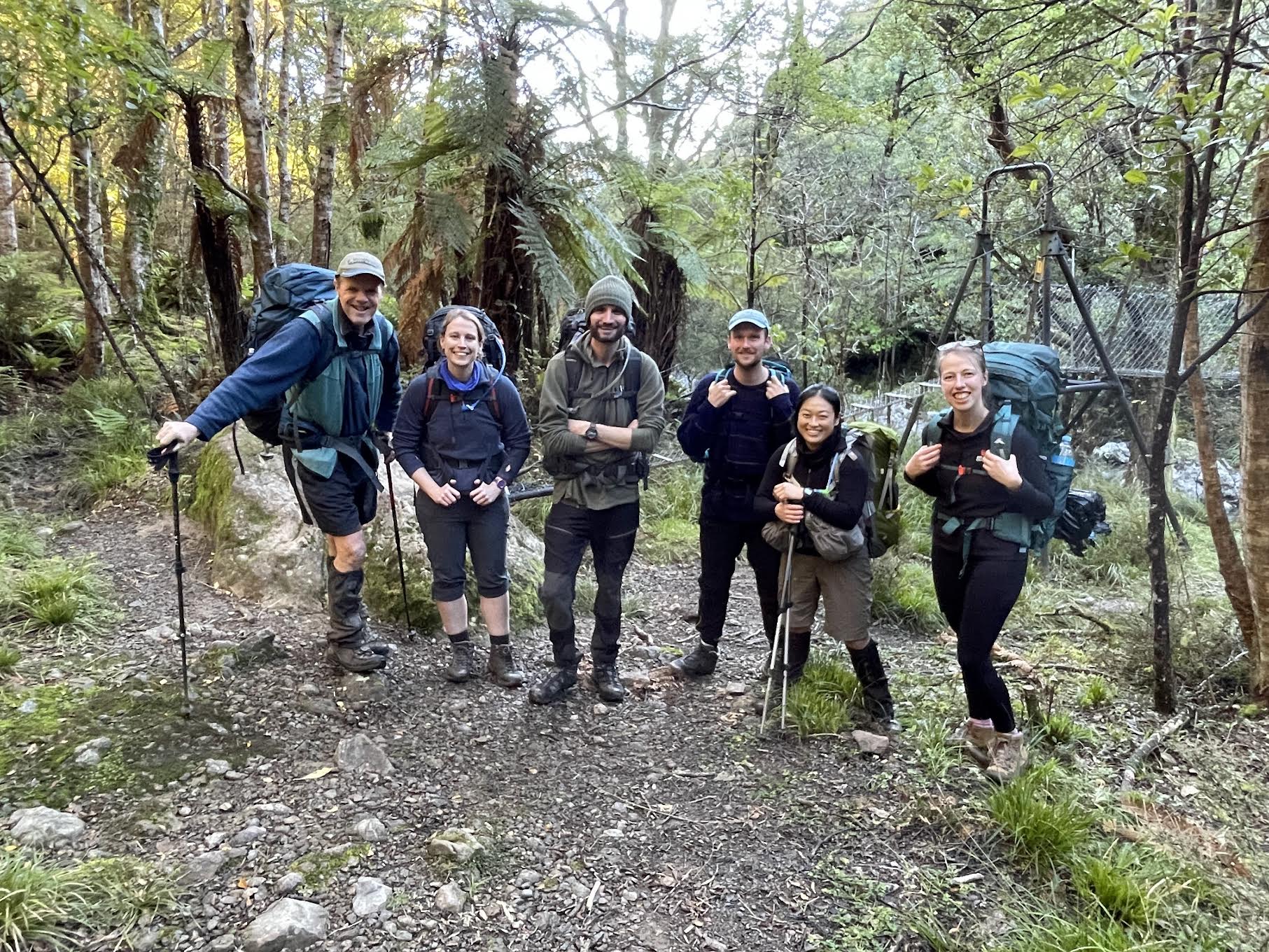Nei te mihi maioha ki ngā kaitiaki o Tararua maunga. Arā, ko Rangitāne o Tāmaki nui-ā-Rua, ko Ngāti Kahungunu ki Wairarapa, ko Muaūpoko, ko Ngāti Toa Rangatira, ko ngā iwi o taua wāhi katoa hoki. Tēnā koutou katoa.
A warm thanks to the guardians of the Tararua range. Namely, Rangitāne o Tāmaki nui-ā-Rua, Ngāti Kahungunu ki Wairarapa, Muaūpoko, Ngāti Toa Rangatira, and all of the tribes of that region also. Thanks to you all.
Ko te nuinga o mātou i tūtaki mātou i te teihana rerewē o Pōneke i te 7.30am i te Rāhoroi, ā, ka tīkina i a Brianna mai i Whakaoriori. E ai ki te matapae huarere, ka wātea te huarere i te Rāhoroi, ā, ka heke iti i ngā ua i te ahiahi o Rātapu.
The majority of the group met at Wellington Railway Station at 7.30am on Saturday, and we picked up Brianna from Whakaoriori (Masterton) along the way. The weather was forecast to be clear on Saturday with rain developing late on Sunday.
Ka kī a Anarau, nāna i rere mai i Kōtirana i te mutunga o i tērā tau, kāore ia i te hīkoi tairoa i mua atu. He hīkoi tuatahi tēnei hīkoi ki a Anaru rāua ko Brianna i te taha o te karapu.
Andrew, who flew over from Scotland late last year, noted that he had never been overnight tramping before. Our trip to Roaring Stag Hut would also be Andrew and Brianna’s first trip with the club.
Whai muri i taraiwa mātou mō tata ki te rua ngā hauora me te hawhe, i tae ake mātou i Putara rori, ā, i tīmata mātou i te hīkoi i muri tata iho i te tēkau karaka kei raro i ngā whiti hūmārire o te rā. Nāwai, nāwai, ā, ka tae ake mātou i te arawhiti tuatahi kei whakawhiti i Mangatainoka awa. I hangaia mai i te mea pērā i te waea heihei, i hīkoi mātou katoa ki te āta haere ki te whakawhiti. I muri iho āhua kōtahi hauora i te hīkoi (mai i te tūnga waka), i tae ake mātou ki te arawhiti tuarua āhua roa ake, ā, ka tīmata mātou ki te hīkoi ki runga!
After about 2 1/2 hrs of driving, we made it to Putara Road end, and started our hīkoi (walk) shortly after 10am in the afternoon sun. Not long into the walk, we came across a swing bridge across Mangatainoka awa (river) (‘manga’ meaning ‘stream’, and ‘tainoka’ – a native Broom plant found in the North Island https://www.nzpcn.org.nz/flora/species/carmichaelia-australis/). The bridge was made out of something that resembled chicken wire and we all took turns balancing carefully to get across. After about an hour’s walk from the carpark, we reached a slightly longer second bridge, and then we started to climbing!
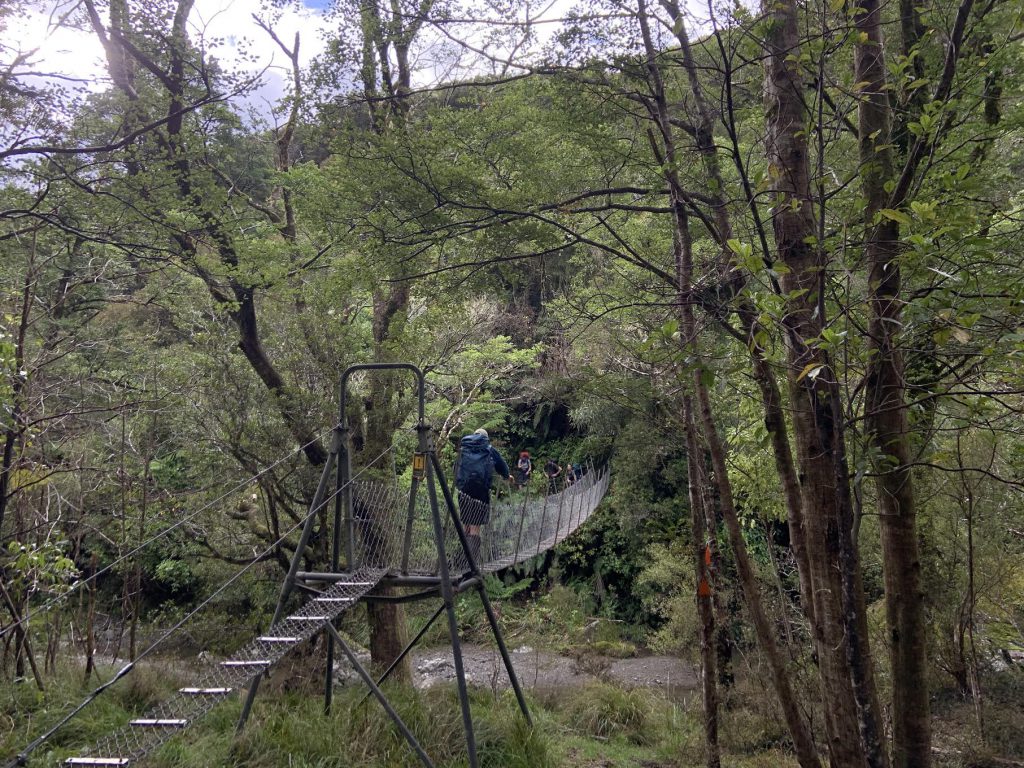
I a mātou e haere ana ki te tūtakitanga, i kite me te kī a Anaru, ‘Whakamīharo, ka hanga i ngā paiaka o ngā rākau i ngā arapiki’. Tāria te wā, whai muri i te piki uaua ki runga, nā Tom i a mātou i whakahaere ki te tūtakitanga, kei reira i tū ai mātou mō te tina. I muri i te tina, i ngāwari heke ki te whare pūrokuroku ‘Roaring Stag’, ā, ka tae ake mātou i mua tata atu i te 3 karaka. E rima hauora ana te roa i te hīkoi me te tina ki te haere atu ki te whare pūrokuroku. Ko tētahi tangata noa i te whare pūrokuroku, nā, nō mātou te whiwhi ki te whakarite i ō mātou peke moe i te wāhi moenga. I noho mātou ki te pāinaina kei raro i te whitinga o te rā mō te wā poto. I kōrerotia e Sarah me hoko ia i pūtu hōu, nō ōna hū i auheke ki te oru.
As we made our way up towards a junction, Andrew observed and noted, ‘It’s cool how the tree roots make steps’. Eventually, after a challenging uphill climb, Tom led us to the junction where we stopped for lunch. After lunch, it was a gentle descent down to Roaring Stag Hut, and we arrived just before 3pm. It had been about a 5 hour walk (including our lunch stop) to get to the hut. There was only one other person in the hut (a hunter), so we were lucky to each be able to set up our sleeping bag in a bunk. We sat for a little while basking in the afternoon sun, and Sarah admitted she may need to buy new boots after her well-worn boots succumbed to the bog.
Ā muri ake nei i te ahiahi, nā Emily i a mātou i tuarā ki te hīkoi ki te roto e tata ana i te whare pūrokuroku. I whakatau i a Tony ka noho tonu ia i te whare pūrokuroku, ā, e whakatā tonu ana ia kei raro i te whitinga o te rā. I hiahia i ngā toenga o mātou ki te haere ki te kite i te roto. I whakawhiti mātou i te arawhiti kei runga i ētahi toka. I a Emily i te whakawhiti i te awa, ā, i a Elizabeth e tata ana ki te kuhu atu ōna waewae i roto i te wai, ka mutu i a Anarau me te kī, “kāore au i te pīrangi ki te mākū ōku hū. Ka āhei ki te tangohia ōku hū.” Whai muri i tīwaha ngātahi i a Emily rāua ko Elizabeth, “E kāo!”, ā, i whakamāramatia e Emily i ngā ture mō te whakawhitinga i ngā awa 101, ka whāki i ētahi atu kāore rātou i te pīrangi ki te mākū ō rātou hū hoki. I whakatau i a mātou ki te hoki atu ki te whare pūrokuroku, ā, e whakatau ana i a Emily ki te hoki atu mā i te awa, nō mākū kē ōna pūtu.
Later in the afternoon, Emily offered to take us to a lake near the hut. Tony opted to stay at the hut and continued resting in the afternoon sun. Everyone else was keen to go see the lake. We made our way across a nearby bridge and over some rocks. As Emily crossed the river and Elizabeth almost got her feet wet in the river, Andrew stopped and said that he didn’t want his shoes to get wet, so he was going to take off his shoes. Elizabeth and Emily then yelled out “no!” in unison and Emily explained the rules of river crossing 101. A few of the others in the group also revealed that they did not want to get their shoes wet. We therefore decided to turn back and return to the hut. Emily opted to walk back through the river – since she had already gotten her boots wet.
I te whare pūrokuroku, ka kai tahi mātou i te kihu parāoa satay mai i te pukapuka tunu kai o WTMC mō te hapa, ā, ka kāinga e mātou ētahi huarākau kaiota nā Tony i whakarite. I taua pō, i pūhi angitu i te kaiwhakangau i tētahi tia kūao. Ko Brianna te rata kararehe i whakamārama ia, ka tapaina i te tia kūao “spike”, nā te iti o ngā maire pūhouhou, ā, ko Anaru i whakapoapoa i a mātou ki ngā putiputi whētuitui. Ko Sarah rātou ko Brianna, ko Anaru, ko Tony hoki i noho tonu i te tōmuringa ki te purei “Cactus” (heoi, he ingoa anō i Kōtirana – he kupu ka tīmata i te ‘B’, ā, ka mutu i te ‘T’). Nāwai rā, ka moe mātou katoa i roto i te whare pūrokuroku mahana me te whakarongo i te māturu kāwatawata o te wai e tata ana.
Back at the hut, we had satay noodles from the WTMC cookbook for dinner, and some delicious fresh fruit courtesy of Tony. That evening, the hunter staying at the hut shot a young deer. Veterinarian Brianna explained that a young deer is called a “spike” -because of its small underdeveloped antlers, and Andrew serenaded us with origami flowers. Sarah, Brianna, Andrew, and Tony stayed up late playing rounds of the game”Cactus” (but called something else in Scotland – a word beginning with ‘B’ and ending in ‘T’). Eventually, we all fell asleep in the warm hut listening to the gentle trickle of water close by.
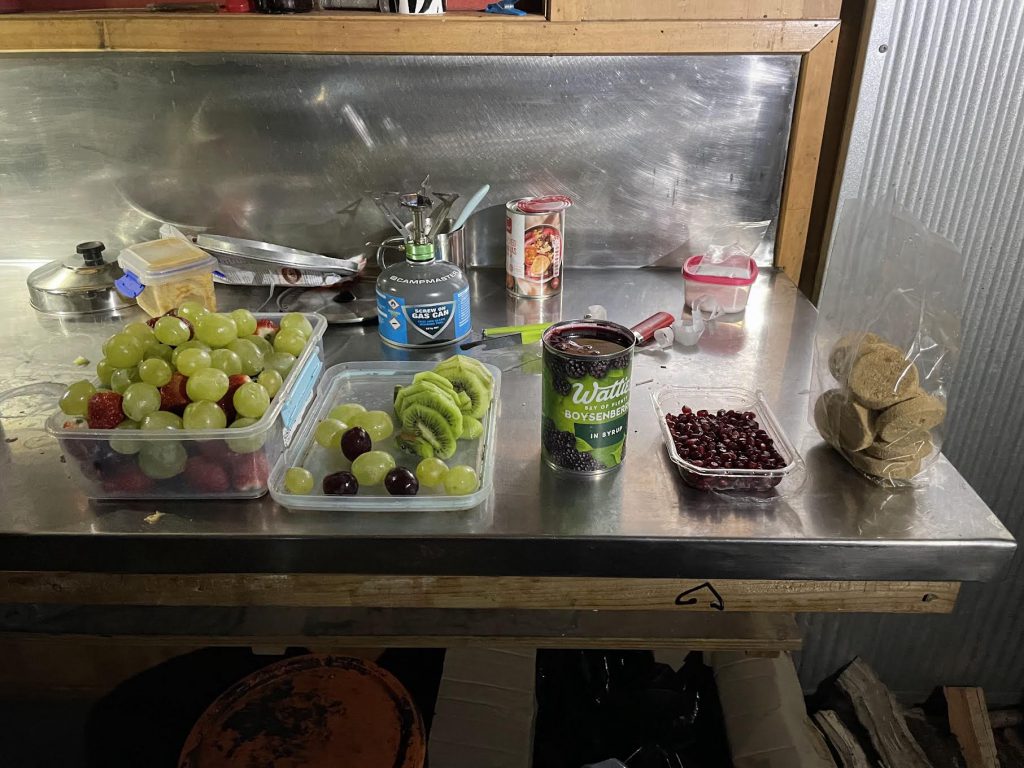
Ao ake i te ata i te Rātapu, i māhinahina i ngā kapua, ā, e kōpatapata mai ana i te ua. Heoi, ko te nuinga o te ua i matapae ki te heke mai auina iho i te ahiahi, nā, kāore mātou i tino āwangawanga e pā ana ki te huarere. I ohaoha te wā oho ki a mātou, ā, ka wehe atu mātou i te whare pūrokuroku i te 8.35am.
In the morning, the clouds were grey and it was drizzling. However most of the rain was forecast for later that afternoon, so we weren’t too concerned. We had a generous sleep in and left the hut at around 8.35 am.
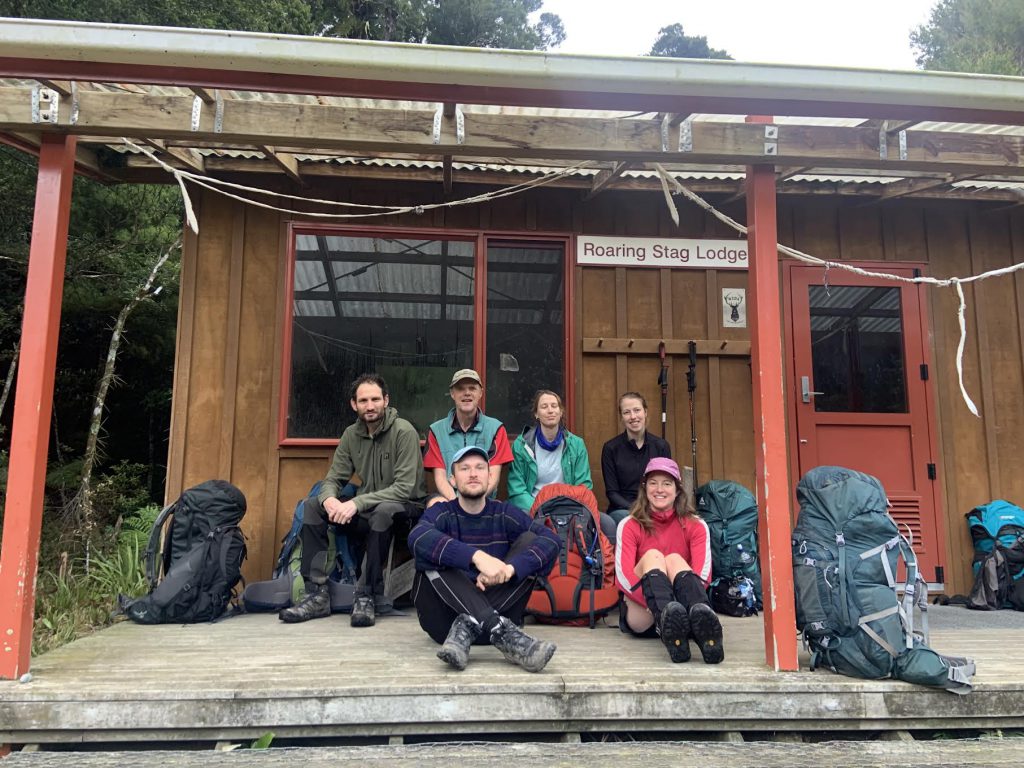
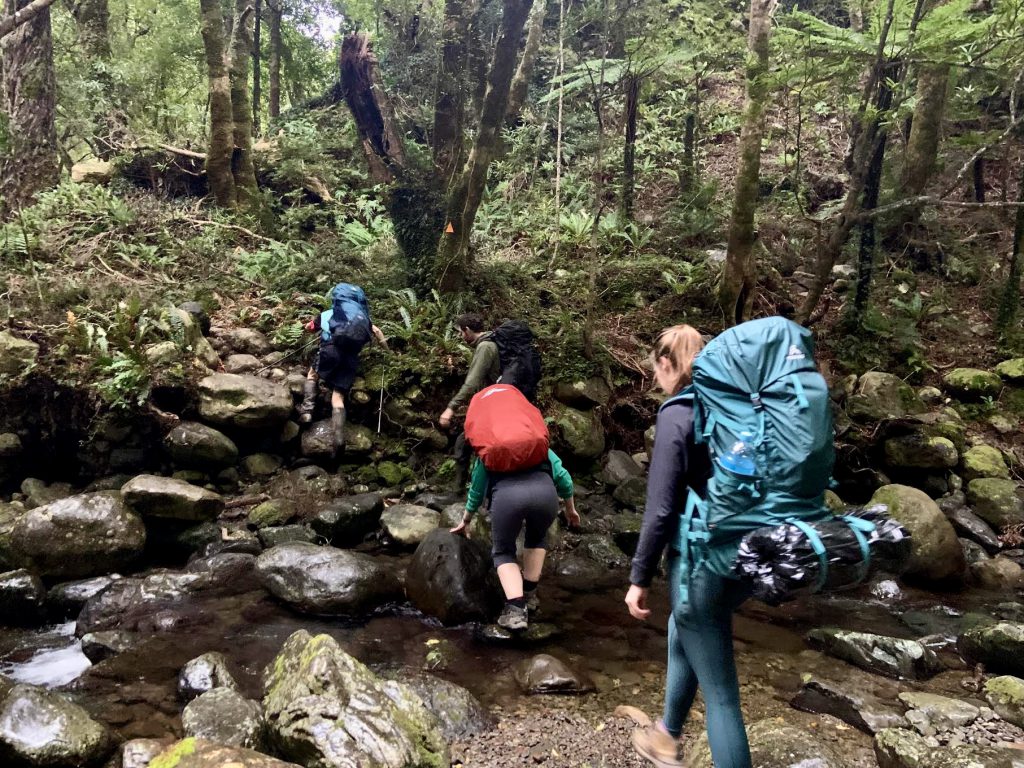
I piki ngāwari ki runga ki te te huarahi mai i te whare pūrokuroku, ā, ka hoki mai mātou ki te tūtakitanga i te takiwā i te 10am. Whai muri i te paramanwa, i whakahohe i a mātou, ā, i reri mātou ki te heke ki raro. I muri iho, i āta hīkoi kei runga i ngā paiaka, ā, i karoa te oru, ka hoki mai mātou i te taha o Mangatainoka awa. I whakawhiti mātou i te arawhiti tuatahi i takiwā i te 11am, ā, i te arawhiti tuarua, 45 miniti i muri mai. I muri tata mai, i hoki mai mātou i te tūnga waka i te takiwā i te 11.45am. I iti iho i ngā tōru hāora ki te hoki atu ki te tūnga waka, tae ana ki te paramanawa. I te mea ka panoni i ngā kapua kia māhinahina , ka hoki atu mātou ki Whakaoriori, ā, ka tū mātou i Masterton Bakery & Coffee mō te paramanawa.
It was a gentle climb back up onto the track from the hut, and we were back at the junction at around 10am. After morning tea, we were energised and ready for our climb back down. After carefully walking over tree roots and dodging bogs, we were soon back down next to the Mangatainoka River. We crossed the first bridge on our way back at around 11 am, and crossed the second one about 40 minutes later. And shortly thereafter we were back at the carpark (at around 11.45 am). It had taken less than 3 hours to return back to the carpark (including morning tea).
As the clouds started to turn grey, we made our way back to Whakaoriori, stopping at Masterton Bakery & Coffee for some afternoon tea.
Whai muri i whakakī i ō mātou puku ki ngā maramara wera me ngā kōpaki, ka poroaki mātou i a Brianna, ā, i taraiwa a Emily i a mātou hoki atu ki Pōneke, ā, i a mātou e toe ana i mātakitaki i te ua ka heke ake. I hoki mai mātou ki te teihana rerewē o Pōneke tata ki te 3pm.
After filling our bellies with hot chips and pies, we said our farewells to Brianna. Emily then drove us back to Pōneke (Wellington) as the rest of us watched more rain fall. We arrived back at Wellington Railway Station close to 3pm.
He mihi nunui ki a Emily mō tāna āwhina ki a Elizabeth mō tōna wheako tuatahi ki te whakahaere i tētahi tiripi.
A special thanks to Emily for supporting Elizabeth on her first time leading a trip.

